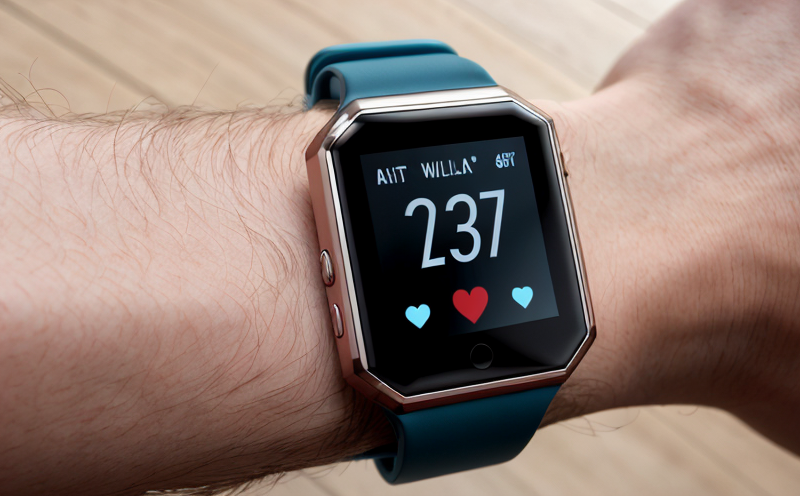IEC 60068-2-32 Drop Testing for Wearable Health Devices
The International Electrotechnical Commission's (IEC) standard IEC 60068-2-32 specifies the requirements for drop tests, which are crucial to ensure that wearable health devices can withstand accidental impacts. This test is particularly important in sectors like consumer electronics and medical technology where products must be robust enough to handle everyday use without compromising safety or functionality.
The primary goal of this testing method is to evaluate a device's ability to endure drops from various heights onto different surfaces, simulating real-world scenarios such as accidental falls. The standard aims to provide manufacturers with a standardized approach to ensure product reliability and compliance with regulatory requirements.
During the test, specimens are subjected to controlled impacts using specified impact energies and drop heights. The testing apparatus typically includes a device stand for positioning the specimen vertically or horizontally, depending on the orientation required by the standard. Impact force is measured using strain gauges or load cells, ensuring accurate data collection.
For medical devices, especially those used in close proximity to human skin, additional considerations must be made regarding material compatibility and biocompatibility. This ensures that even if a device falls and impacts a surface, it does not release harmful substances into the environment or the user's body.
| Parameter | Description |
|---|---|
| Test Specimens | The specimens tested are representative of the device to be evaluated. They include various sizes and configurations that reflect real-world use. |
| Drop Heights | Drops occur from heights ranging between 0.25 m and 1.25 m, depending on the specific requirements of the device being tested. |
| Surfaces | The surfaces onto which drops are made include concrete, steel, and wood, simulating common ground materials in environments where the devices may be used. |
| Impact Force Measurement | Strain gauges or load cells measure impact forces to ensure precise data collection for analysis. |
The testing protocol is designed to be both rigorous and reproducible, allowing manufacturers to replicate the test conditions under which their devices might encounter accidental impacts. Compliance with IEC 60068-2-32 ensures that wearable health devices meet international standards for safety and reliability.
Failure criteria are defined in the standard; a device fails if it shows significant deformation, functional failure, or releases harmful substances during the test. These criteria ensure that only robust, reliable products pass the testing process.
Scope and Methodology
- The standard covers devices intended for use in environments where they may experience accidental impacts.
- It applies to wearable health devices, including fitness trackers, smartwatches, and other similar products.
- Testing is conducted on prototypes or production units that are representative of the final product design.
| Test Parameters | Description |
|---|---|
| Impact Energy | The energy of the impact is calculated based on the drop height and surface material. |
| Test Specimens | The specimens are representative of the device to be evaluated, including various sizes and configurations. |
| Drop Orientation | Drops can occur in any orientation depending on the specific requirements of the device being tested. |
The testing process is designed to replicate real-world scenarios where devices might encounter accidental impacts. This ensures that manufacturers have a standardized approach to ensuring product reliability and compliance with regulatory requirements.
Failure criteria are defined in the standard; a device fails if it shows significant deformation, functional failure, or releases harmful substances during the test. These criteria ensure that only robust, reliable products pass the testing process.
Quality and Reliability Assurance
- All tests are conducted in a controlled environment to ensure consistent results.
- Data from multiple tests is analyzed to determine compliance with IEC 60068-2-32 standards.
- Manufacturers must provide evidence of compliance through test reports and data logs.
Quality assurance in drop testing involves rigorous adherence to the protocol, accurate measurement of impact forces, and consistent recording of results. This ensures that each test is conducted under standardized conditions, which is crucial for maintaining product reliability and ensuring safety.
Data from multiple tests are analyzed to determine compliance with IEC 60068-2-32 standards. Compliance can be demonstrated through the provision of detailed reports that include raw data, analysis results, and any deviations from the standard.
Use Cases and Application Examples
| Application Example | Description |
|---|---|
| Fitness Trackers | Testing ensures that fitness trackers can withstand drops from a height of 1 meter onto concrete, wood, or steel surfaces. |
| Smartwatches | Smartwatches are tested to ensure they can handle impacts equivalent to those encountered during daily activities. |
| Blood Glucose Monitors | Testing ensures that blood glucose monitors remain functional after being subjected to various drop heights and surfaces. |
The use cases for IEC 60068-2-32 are wide-ranging, covering devices used in consumer electronics as well as those critical to medical applications. The standard ensures that all wearable health devices can withstand accidental impacts without compromising their functionality or safety.
By ensuring compliance with this international standard, manufacturers can demonstrate the reliability and robustness of their products, thereby gaining a competitive edge in the market.





